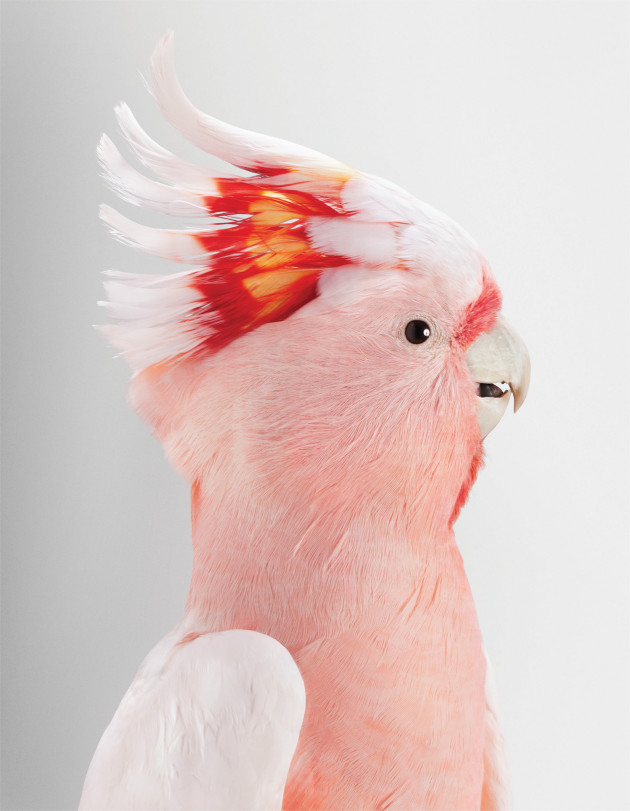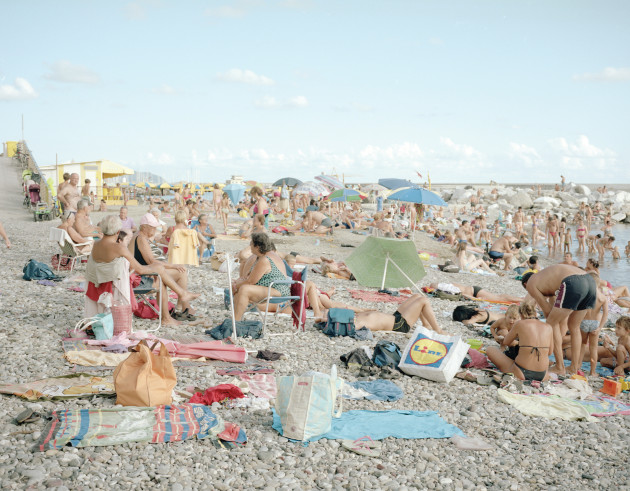Exhibitions are not the cheapest way to get attention for your work, but they hold possibilities unique to other avenues. So should you exhibit? How do you exhibit? In part one this two-part feature, Lyndal Irons speaks with leading curators and artists for their insights into how seasoned professionals, fine art photographers or emerging shooters alike can get a foot in the gallery door.
Gallerist Tom Evangelidis, from Black Eye Gallery in Sydney, likens exhibiting to music. “It’s kudos,” he explains. “You rehearse in your studio every week, but eventually you want to go out and perform. It’s your performance as a photographer - that’s why it’s called a show.”

Exhibiting can be expensive, and there’s much hard work involved. But there is something about those nerves, that difficulty and the direct contact with your audience that cannot be replaced by online alternatives. “People buy books, but they don’t buy prints online. When you are spending thousands of dollars on art it is really important to see the art ‘in the flesh’. I think that is paramount,” says Evangelidis. “While I think the Net is great for advertising, I still think people buy when they come in, see the work and have a physical connection to it.”
When used in a wider mix of promotional avenues, exhibitions can greatly benefit a photographic career. Whether you are making the jump from commercial work into the fine art scene or an emerging photographer taking their first steps into building an exhibition history, below is what you need to consider before planning your first exhibition.
Do you have a body of work?
Exhibiting takes more than just good work; it takes a body of original images, thoughtfully edited to fit a space. Before approaching a gallery, photographers need to invest time, and often money, in shooting and editing a serious body of work that will sit well together on gallery walls. “A lot of photographers are showing us their best images, but not a body of work,” says Evangelidis. “That is a mistake. I don’t care how many great pictures you’ve taken over the years, I want to see a show. The second thing is that photographers need to do their research and make sure their work is unique. It is much harder for me to sell or promote a show that looks like someone else’s work. Think of a great idea, execute it well, then the world is your oyster.”
Gaining a reputation as an artist takes a similar amount of commitment and dedication as a commercial photographic career. Not every shooter can successfully make the cross-over, but it isn’t impossible. Based on 20 year’s experience as a curator and photographer, Sandy Edwards believes there is a “terrible disjunction” between commercial photography and art photography in Australia and overseas. “Because I was working as a commercial photographer, I came in feeling very defensive on behalf of commercial photographers because I knew there were some bloody good ones out there doing good work,” she recalls. “However, we have to learn to decipher what the difference is between commerce and art. It doesn’t mean that you can’t do both. But if you think about where your time goes in commercial photography, if you are on deadlines all the time, how do you get the artwork going around that? It’s hard. Now, I think there is a new generation of young photographers who really believe they can do it all. And that belief will be what drives them.”

Know your gallery options
There are a limited number of galleries in Australia that deal primarily in photography, and this is partially intentional and in response to the buyers’ market. Consequently, photographers should not be too proud to start building their reputation in informal spaces such as cafes, through group shows and rental galleries before they can expect to
be taken seriously by an established or commercial gallery.
Rental spaces typically hand over the key and leave the photographer to do the rest - and there can be a lot to do. An artist often needs to be available to sit in the gallery and run their own opening as well as doing the bulk of work towards promotion.
Artist Run Initiatives (ARIs) often act as the next step in artistic recognition as curated spaces that showcase talent. Not-for-profit resource centres including The Centre for Contemporary Photography (Melbourne) and The Australian Centre for Photography (Sydney) offer another avenue for quality work to be exhibited in a reputable gallery without the pressure of sales. However, the wait to have an exhibition in these spaces can often be quite long.
“CCP offers something quite different from a commercial space, although both avenues have advantages,” explains Director Naomi Cass. “At CCP, you will work with a curator who takes an active interest in your exhibition and may engage with you in selecting the final work. Importantly, your work will be experienced within the context of other photography, other voices and approaches that often brings novel and different ways of reading your work. You will receive a small artist’s fee and you will benefit from CCP’s large and diverse audience, as well as media coverage.”
For many, Australia’s top-level fine art galleries and institutions are the ultimate goal. But photographers should not expect to be fast-tracked there without hard work, warns Edwards. “The first time you have an exhibition, it doesn’t matter where it is in a way,” she says. “It is just to give you the experience so you know what all the steps are. The idea is to be baptised by your first show, then the next time you do it, you might start thinking about the venue. If you start in an ARI, you may have one more show there and then you may look around and decide that you want to up you profile,” Edwards says. “The only way you can get your reputation is to start with one exhibition, and then have another and another - that is how it builds. Maybe after your third exhibition you could consider approaching venues like Stills Gallery, in Sydney, and ask them to look at your work.”
Approach your chosen gallery

While approaching a gallery may seem intimidating, the process is straightforward. It is as simple as calling the venue’s front desk to ask about their favoured method for receiving submissions. Some galleries are open for submissions all year. Others, like the CCP, evaluate work by committee on an annual basis. Jason McQuoid, the director of Melbourne’s Edmund Pearce Gallery, says it is best to have a professional and business-like attitude when making an approach. “Like anything, do your research first - look at the artists we exhibit and represent and determine whether your work would fit. Then approach us with a small selection of work. From there, we normally pick up the conversation and have a meeting to discuss it further.” He advises emerging photographers to be tenacious. “It’s not that hard to have an exhibition as there are a number of viable venues for emerging artists - whether it be Artist Run Initiatives, festivals, prizes and group shows. I’d suggest having as many exhibitions as possible - one to two a year, if not more. It hones your practice and indicates that you are dedicated.”
Curating for a space
Edwards believes there is often a misunderstanding about the word “curation”. “Every space has its own dynamic and the work has to be curated for that particular space. It might mean you have to drop something you were really fond of or change the way you’ve edited.”
There are no fixed rules when it comes to presenting work, but there are trends. Today, photographers have a plethora of printing and hanging methods to choose from. Questions like where to sign, whether to hang using gatorboard or aluminium-based materials, whether to print work full bleed or include a white border, all carry implications. “All those decisions count and if you don’t look at what other people are doing in other galleries, you’re not educating yourself about what is available, what is of the moment,” says Edwards. “You may disagree with what is of the moment, but it’s still good to know when you are thinking about how to position yourself.”
Photographers starting out on a budget may be tempted to cut costs by doing away with frames and pinning work to the walls. But they do so at a risk of environmental damage and likely cost of a reprint should the work sell. A rather novel approach from Black Eye Gallery is to actually hire out frames to those exhibiting, thereby saving them a small fortune in framing costs.
If you’re planning on exhibiting interstate, or even internationally, and your work is framed, you can expect to incur significant costs in terms of shipping and insurance, so venues other than your own city before you’re fully established might not be a feasible option.
Pricing and editioning
Like framing, editioning is subject to trends concerning the number, size and price of the work. Artists can release new editions at a different size at a later date but sales depend on buyer trust. In an easily reproducible medium, collectors are less likely to buy if they feel their new print will be made less valuable by subsequent editions. This may also carry repercussions for artists and galleries, although it’s worth investigating the recent case in the US involving art photographer William Eggleston.
Photographer Chris Round advises keeping them affordable; certainly until you’ve established yourself. “It’s better to have them on someone else’s wall, not your own. Editioning is harder. I’ve had editions of five that should have been ten or more because they sold out quicker than I expected. If they are small prints, you might want to consider an edition of 10-15 and reduce the edition numbers with each size increase.” New exhibitors need to balance the desire to price to sell with avoiding “low self-esteem” when it comes to pricing. And don’t forget to also factor in that most galleries will charge a commission
of between 25-40% of the sale price.

Katrin Koenning has exhibited widely, both nationally and abroad. “Pricing and editioning, the more business-end of your work, develops with time. There are many streams of thought about this within the industry but generally I would advise keeping your editions small and ‘easy to navigate’. There more work you show and sell, and the more you get picked up, the more solid you can become with pricing. You may not start out at selling works for, say, $2,000, but this will change over time.”
It’s also important to be realistic about how much of your show you’ll actually sell, and whether the exercise is important purely from the perspective of getting your name out there and raising your profile.
“I say to people, ‘Who are the people you know who are most likely to buy your work?’ It’s usually friends and family,” said Edwards. “People get really excited by the idea that by having an exhibition, people will walk in and say, ‘Wow these are brilliant. I have to have it!’ But people who are buying art tend to want to know what the reputation of the artist is.” Clearly, building a solid reputation takes time, and this and other topics will be addressed in part two of this feature.
Contacts
Centre for Contemporary Photography ccp.org.au
Sandy Edwards (Arthere) arthere.com.au
Tom Evangelidis (Black Eye Gallery) blackeyegallery.com.au
Katrin Koenning katrinkoenning.com
Jason McQuoid (Edmund Pearce Gallery) edmundpearce.com.au
Chris Round roundtheplace.com


